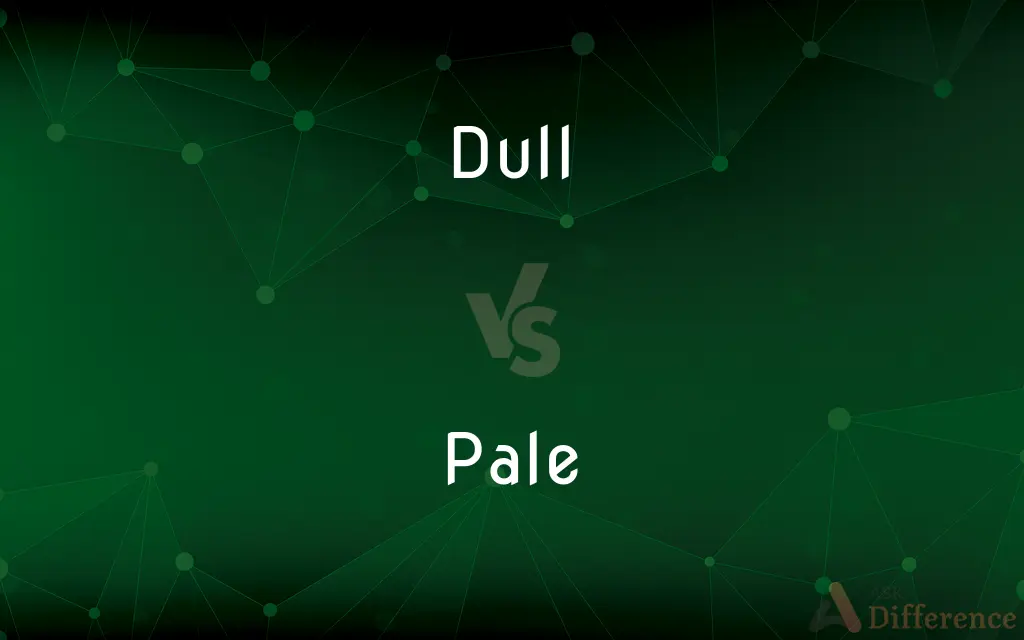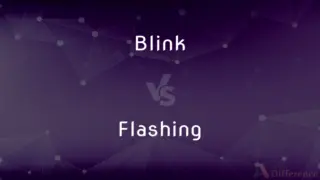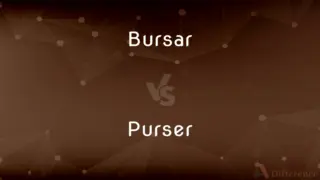Dull vs. Pale — What's the Difference?
By Fiza Rafique & Maham Liaqat — Updated on April 3, 2024
Dull refers to a lack of brightness or luster, often implying a muted or subdued appearance, whereas pale describes a lightness of color, suggesting a lack of intensity or vibrancy.

Difference Between Dull and Pale
Table of Contents
ADVERTISEMENT
Key Differences
Dull is commonly used to describe something that lacks brightness or sheen, suggesting an absence of gloss or sparkle. For instance, a dull finish on a piece of furniture might refer to its matte texture, lacking the reflective quality of a polished surface. On the other hand, pale is used to denote a reduction in color's intensity, often implying a washed-out or less vibrant hue. A pale blue, for example, would be a light, soft shade of blue, significantly less saturated than a vivid or deep blue.
While dullness can affect perception by reducing visual interest or appeal, paleness might convey a sense of delicacy or subtlety. A dull color might seem unremarkable or flat, lacking in depth or vividness. Conversely, a pale color can evoke a sense of lightness or airiness, offering a more understated aesthetic. This contrast highlights how both qualities can influence visual and emotional responses differently.
In terms of application, dullness often carries a negative connotation, suggesting a lack of liveliness or excitement in various contexts, not just visual. A dull sound, for instance, lacks sharpness or clarity. Pale, however, is more neutral and can be desirable in certain situations, such as fashion or design, where a soft or muted effect is preferred.
The concept of dullness extends beyond the visual, applying to sensory experiences like taste and sound, indicating a lack of sharpness or intensity. Paleness, while primarily visual, can also describe a lack of vigor or health, as in a person's complexion. This demonstrates how both terms can metaphorically extend to describe other sensory experiences or conditions.
Dull and pale can both signify a lack of something (brightness or color intensity, respectively), but their implications vary significantly across different contexts. Dull often suggests something is uninteresting or lacking in vitality, while pale might imply a gentle, subdued quality, potentially desirable depending on the context.
ADVERTISEMENT
Comparison Chart
Definition
Lacking brightness or sheen; not sharp or clear
Light in color or having little color
Common Uses
Describing surfaces, sounds, or general lack of interest
Describing color intensity, health, or emotional states
Connotations
Often negative, implying boredom or lack of excitement
Neutral to positive, implying subtlety or softness
Sensory Application
Visual, auditory, and tactile
Primarily visual, occasionally metaphorical (e.g., health)
Desired Context
Rarely desired, unless for specific aesthetic or sensory reasons
Often desired in fashion, design, or to describe natural lightness
Compare with Definitions
Dull
Lacking brightness or luster.
The old coin had a dull finish.
Pale
Light in color or having little color.
She painted her room a pale shade of pink.
Dull
Not sharp or clear in sound or sight.
The concert was ruined by the dull sound quality.
Pale
Lacking intensity of color; whitish.
Her face turned pale with fear.
Dull
Slow to understand or perceive; stupid.
He gave a dull look, not understanding the joke.
Pale
Dim or feeble.
The pale light of dawn crept through the curtains.
Dull
Not sharp or pointed; blunt.
The dull knife struggled to cut through the bread.
Pale
Weak or faint.
His excuses were pale and unconvincing.
Dull
Lacking interest or excitement.
The lecture was so dull that several students fell asleep.
Pale
Of health: poor or weak.
He was looking pale after his illness.
Dull
Arousing little interest; lacking liveliness; boring
A dull movie.
Pale
Light in colour or shade; containing little colour or pigment
Choose pale floral patterns for walls
Dull
Not brisk or rapid; sluggish
Business has been dull.
Pale
Inferior or unimpressive
The new cheese is a pale imitation of continental cheeses
Dull
Not having a sharp edge or point; blunt
A dull knife.
Pale
Become pale in one's face from shock or fear
I paled at the thought of what she might say
Dull
Not intensely or keenly felt
A dull ache.
Pale
Seem or become less important
All else pales by comparison
Dull
Not bright, vivid, or shiny
A dull brown.
A glaze with a dull finish.
Pale
A wooden stake or post used with others to form a fence.
Dull
Cloudy or overcast
A dull sky.
Pale
An area within determined bounds, or subject to a particular jurisdiction.
Dull
Not clear or resonant
A dull thud.
Pale
A broad vertical stripe down the middle of a shield.
Dull
Intellectually weak or obtuse; stupid.
Pale
A stake or pointed stick; a picket.
Dull
Lacking responsiveness or alertness; insensitive
Half-asleep and dull to the noises in the next room.
Pale
A fence enclosing an area.
Dull
Dispirited; depressed
A dull mood.
Pale
The area enclosed by a fence or boundary.
Dull
To make or become dull.
Pale
A region or district lying within an imposed boundary or constituting a separate jurisdiction.
Dull
Lacking the ability to cut easily; not sharp.
All these knives are dull.
Pale
Pale The medieval dominions of the English in Ireland. Used with the.
Dull
Boring; not exciting or interesting.
He sat through the dull lecture and barely stayed awake.
Pale
(Heraldry) A wide vertical band in the center of an escutcheon.
Dull
Not shiny; having a matte finish or no particular luster or brightness.
Choose a dull finish to hide fingerprints.
A dull fire or lamp;
A dull red or yellow;
A dull mirror
Pale
To enclose with pales; fence in.
Dull
Not bright or intelligent; stupid; having slow understanding.
Pale
To cause to turn pale.
Dull
Sluggish, listless.
Pale
To become pale; blanch
Paled with fright.
Dull
Cloudy, overcast.
It's a dull day.
Pale
To decrease in relative importance.
Dull
Insensible; unfeeling.
Pale
Whitish in complexion; pallid.
Dull
Heavy; lifeless; inert.
Pale
Of a low intensity of color; light.
Dull
(of pain etc) Not intense; felt indistinctly or only slightly.
Pressing on the bruise produces a dull' pain.
Pale
Having high lightness and low saturation.
Dull
Not clear, muffled.
Pale
Of a low intensity of light; dim or faint
"a late afternoon sun coming through the el tracks and falling in pale oblongs on the cracked, empty sidewalks" (Jimmy Breslin).
Dull
(transitive) To render dull; to remove or blunt an edge or something that was sharp.
Years of misuse have dulled the tools.
Pale
Feeble; weak
A pale rendition of the aria.
Dull
(transitive) To soften, moderate or blunt; to make dull, stupid, or sluggish; to stupefy.
He drinks to dull the pain.
Pale
Light in color.
I have pale yellow wallpaper.
She had pale skin because she didn't get much sunlight.
Dull
(intransitive) To lose a sharp edge; to become dull.
A razor will dull with use.
Pale
Feeble, faint.
He is but a pale shadow of his former self.
The son's clumsy paintings are a pale imitation of his father's.
Dull
To render dim or obscure; to sully; to tarnish.
Pale
(intransitive) To turn pale; to lose colour.
Dull
Slow of understanding; wanting readiness of apprehension; stupid; doltish; blockish.
She is not bred so dull but she can learn.
Pale
(intransitive) To become insignificant.
Dull
Slow in action; sluggish; unready; awkward.
This people's heart is waxed gross, and their ears are dull of hearing.
O, help my weak wit and sharpen my dull tongue.
Pale
(transitive) To make pale; to diminish the brightness of.
Dull
Insensible; unfeeling.
Think me notSo dull a devil to forget the lossOf such a matchless wife.
Pale
To enclose with pales, or as if with pales; to encircle or encompass; to fence off.
Dull
Not keen in edge or point; lacking sharpness; blunt.
Pale
(obsolete) Paleness; pallor.
Dull
Not bright or clear to the eye; wanting in liveliness of color or luster; not vivid; obscure; dim; as, a dull fire or lamp; a dull red or yellow; a dull mirror.
Pale
A wooden stake; a picket.
Dull
Heavy; gross; cloggy; insensible; spiritless; lifeless; inert.
As turning the logs will make a dull fire burn, so changes of study a dull brain.
Pale
(archaic) Fence made from wooden stake; palisade.
Dull
Furnishing little delight, spirit, or variety; uninteresting; tedious; cheerless; gloomy; melancholy; depressing; as, a dull story or sermon; a dull occupation or period; hence, cloudy; overcast; as, a dull day.
Along life's dullest, dreariest walk.
Pale
(by extension) Limits, bounds (especially before of).
Dull
To deprive of sharpness of edge or point.
Borrowing dulls the edge of husbandry.
Pale
The bounds of morality, good behaviour or judgment in civilized company, in the phrase beyond the pale.
Dull
To make dull, stupid, or sluggish; to stupefy, as the senses, the feelings, the perceptions, and the like.
Those [drugs] she hasWill stupefy and dull the sense a while.
Use and custom have so dulled our eyes.
Pale
(heraldry) A vertical band down the middle of a shield.
Dull
To render dim or obscure; to sully; to tarnish.
Pale
(archaic) A territory or defensive area within a specific boundary or under a given jurisdiction.
Dull
To deprive of liveliness or activity; to render heavy; to make inert; to depress; to weary; to sadden.
Attention of mind . . . wasted or dulled through continuance.
Pale
(historical) The parts of Ireland under English jurisdiction.
Dull
To become dull or stupid.
Pale
(historical) The territory around Calais under English control (from the 14th to 16th centuries).
Dull
Make dull in appearance;
Age had dulled the surface
Pale
(historical) A portion of Russia in which Jews were permitted to live.
Dull
Become dull or lusterless in appearance; lose shine or brightness;
The varnished table top dulled with time
Pale
(archaic) The jurisdiction (territorial or otherwise) of an authority.
Dull
Deaden (a sound or noise), especially by wrapping
Pale
A cheese scoop.
Dull
Make numb or insensitive;
The shock numbed her senses
Pale
Wanting in color; not ruddy; dusky white; pallid; wan; as, a pale face; a pale red; a pale blue.
Speechless he stood and pale.
They are not of complexion red or pale.
Dull
Make dull or blunt;
Too much cutting dulls the knife's edge
Pale
Not bright or brilliant; of a faint luster or hue; dim; as, the pale light of the moon.
The night, methinks, is but the daylight sick;It looks a little paler.
Dull
Become less interesting or attractive
Pale
Paleness; pallor.
Dull
Make less lively or vigorous;
Middle age dulled her appetite for travel
Pale
A pointed stake or slat, either driven into the ground, or fastened to a rail at the top and bottom, for fencing or inclosing; a picket.
Deer creep through when a pale tumbles down.
Dull
Lacking in liveliness or animation;
He was so dull at parties
A dull political campaign
A large dull impassive man
Dull days with nothing to do
How dull and dreary the world is
Fell back into one of her dull moods
Pale
That which incloses or fences in; a boundary; a limit; a fence; a palisade.
Dull
Emitting or reflecting very little light;
A dull glow
Dull silver badly in need of a polish
A dull sky
Pale
A space or field having bounds or limits; a limited region or place; an inclosure; - often used figuratively.
Dull
Being or made softer or less loud or clear;
The dull boom of distant breaking waves
Muffled drums
The muffled noises of the street
Muted trumpets
Pale
A region within specified bounds, whether or not enclosed or demarcated.
Dull
So lacking in interest as to cause mental weariness;
A boring evening with uninteresting people
The deadening effect of some routine tasks
A dull play
His competent but dull performance
A ho-hum speaker who couldn't capture their attention
What an irksome task the writing of long letters is
Tedious days on the train
The tiresome chirping of a cricket
Other people's dreams are dreadfully wearisome
Pale
A stripe or band, as on a garment.
Dull
(of color) very low in saturation; highly diluted;
Dull greens and blues
Pale
One of the greater ordinaries, being a broad perpendicular stripe in an escutcheon, equally distant from the two edges, and occupying one third of it.
Dull
Not keenly felt;
A dull throbbing
Dull pain
Pale
A cheese scoop.
Dull
Slow to learn or understand; lacking intellectual acuity;
So dense he never understands anything I say to him
Never met anyone quite so dim
Although dull at classical learning, at mathematics he was uncommonly quick
Dumb officials make some really dumb decisions
He was either normally stupid or being deliberately obtuse
Worked with the slow students
Pale
A shore for bracing a timber before it is fastened.
Dull
(of business) not active or brisk;
Business is dull (or slow)
A sluggish market
Pale
To turn pale; to lose color or luster.
Apt to pale at a trodden worm.
Dull
Not having a sharp edge or point;
The knife was too dull to be of any use
Pale
To make pale; to diminish the brightness of.
The glowworm shows the matin to be near,And 'gins to pale his uneffectual fire.
Dull
Blunted in responsiveness or sensibility;
A dull gaze
So exhausted she was dull to what went on about her
Pale
To inclose with pales, or as with pales; to encircle; to encompass; to fence off.
[Your isle, which stands] ribbed and paled inWith rocks unscalable and roaring waters.
Dull
Not clear and resonant; sounding as if striking with or against something relatively soft;
The dull thud
Thudding bullets
Pale
A wooden strip forming part of a fence
Dull
Darkened with overcast;
A dark day
A dull sky
A gray rainy afternoon
Gray clouds
The sky was leaden and thick
Pale
Turn pale, as if in fear
Pale
Very light colored; highly diluted with white;
Pale seagreen
Pale blue eyes
Pale
(of light) lacking in intensity or brightness; dim or feeble;
The pale light of a half moon
A pale sun
The late afternoon light coming through the el tracks fell in pale oblongs on the street
A pallid sky
The pale (or wan) stars
The wan light of dawn
Pale
Lacking in vitality or interest or effectiveness;
A pale rendition of the aria
Pale prose with the faint sweetness of lavender
A pallid performance
Pale
Abnormally deficient in color as suggesting physical or emotional distress;
The pallid face of the invalid
Her wan face suddenly flushed
Pale
Not full or rich;
High, pale, pure and lovely song
Common Curiosities
Is dullness always negative?
While often negative, dullness can be desired in contexts that call for subtlety or understatement, such as in certain design preferences.
Is it possible for an object to be both dull and pale?
Yes, an object can be both dull (lacking sheen or sparkle) and pale (light in color), contributing to a very subdued appearance.
Can a bright color also be pale?
Yes, a bright color can be pale if it is a light version of a hue but still maintains some level of saturation.
How does paleness relate to health?
Paleness in complexion often suggests poor health, indicating a lack of blood flow or vitality.
What's the difference between dull pain and pale pain?
Dull pain is characterized by a lack of sharpness, being more of a constant, nagging discomfort. "Pale pain" is not a commonly used term.
Can a personality be described as dull or pale?
A personality can be described as dull if it lacks interest or excitement, but "pale" is not typically used in this context.
Can the atmosphere be described as dull or pale?
The atmosphere can be described as dull in terms of weather (overcast, lacking brightness) or mood (lacking excitement), and as pale in terms of light (dim, weak).
Can sound be described as pale?
Typically, sound is not described as pale because pale refers to visual lightness. However, metaphorically, it might imply a weak or feeble sound.
How do these terms apply to flavors?
A flavor might be described as dull if it lacks intensity, but "pale" is not typically used to describe taste.
What does it mean for a color to be dull?
A dull color lacks brightness and vividness, appearing subdued or muted compared to more vibrant shades.
How do dullness and paleness affect design?
In design, dullness may be used to create a muted, sophisticated look, while paleness can add softness and subtlety to a palette.
Can fabrics be dull or pale?
Fabrics can be both: dull if they lack luster or brightness, and pale if their color is light or washed out.
What is the impact of dullness on perception?
Dullness can make an object or experience seem less engaging or interesting, potentially leading to boredom.
How is paleness perceived in art?
In art, paleness can convey delicacy, subtlety, or a sense of ethereality, depending on the context and contrast with other colors.
What psychological effects do dull and pale colors have?
Dull colors might evoke feelings of sadness or fatigue, whereas pale colors can induce a sense of calmness or purity.
Share Your Discovery

Previous Comparison
Blink vs. Flashing
Next Comparison
Bursar vs. PurserAuthor Spotlight
Written by
Fiza RafiqueFiza Rafique is a skilled content writer at AskDifference.com, where she meticulously refines and enhances written pieces. Drawing from her vast editorial expertise, Fiza ensures clarity, accuracy, and precision in every article. Passionate about language, she continually seeks to elevate the quality of content for readers worldwide.
Co-written by
Maham Liaqat














































